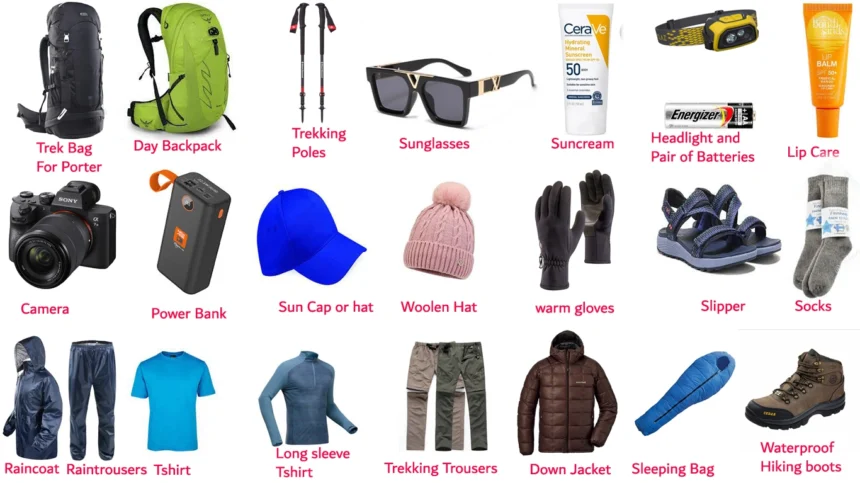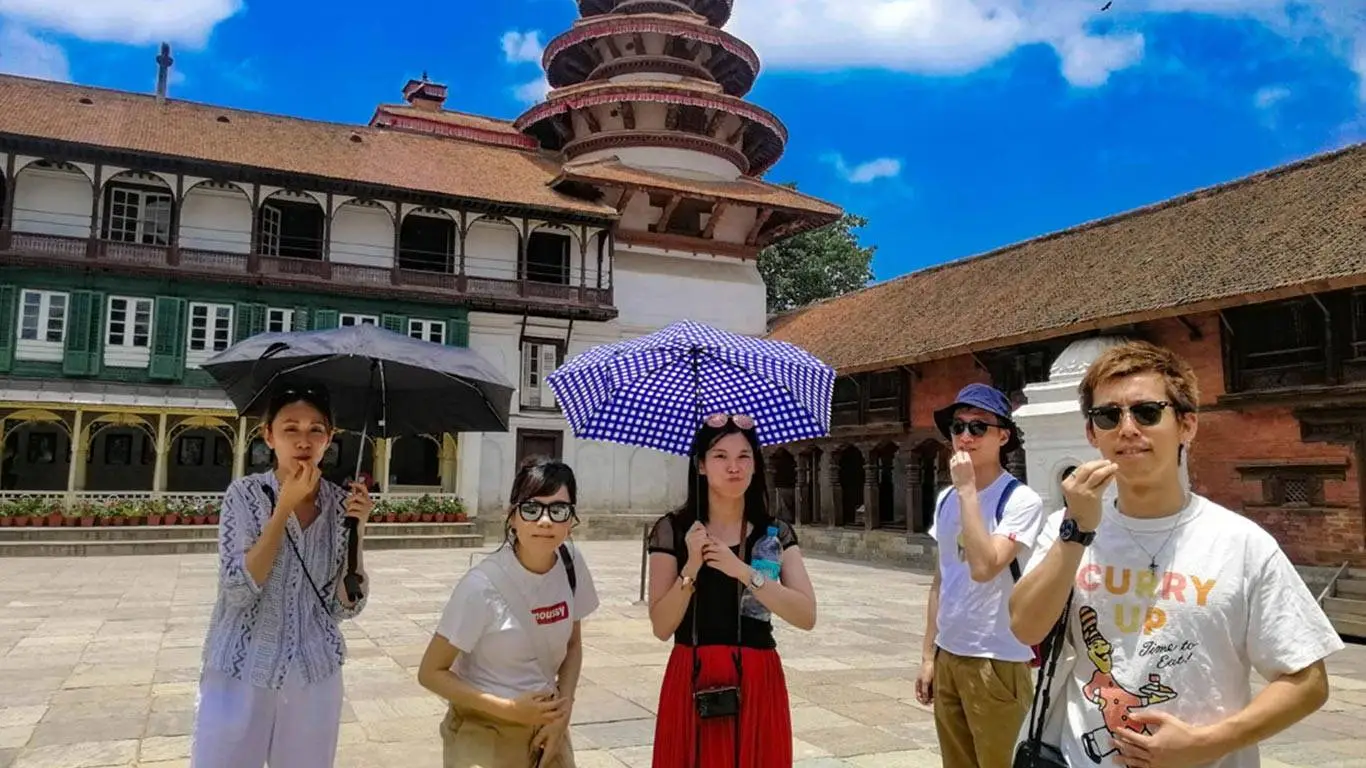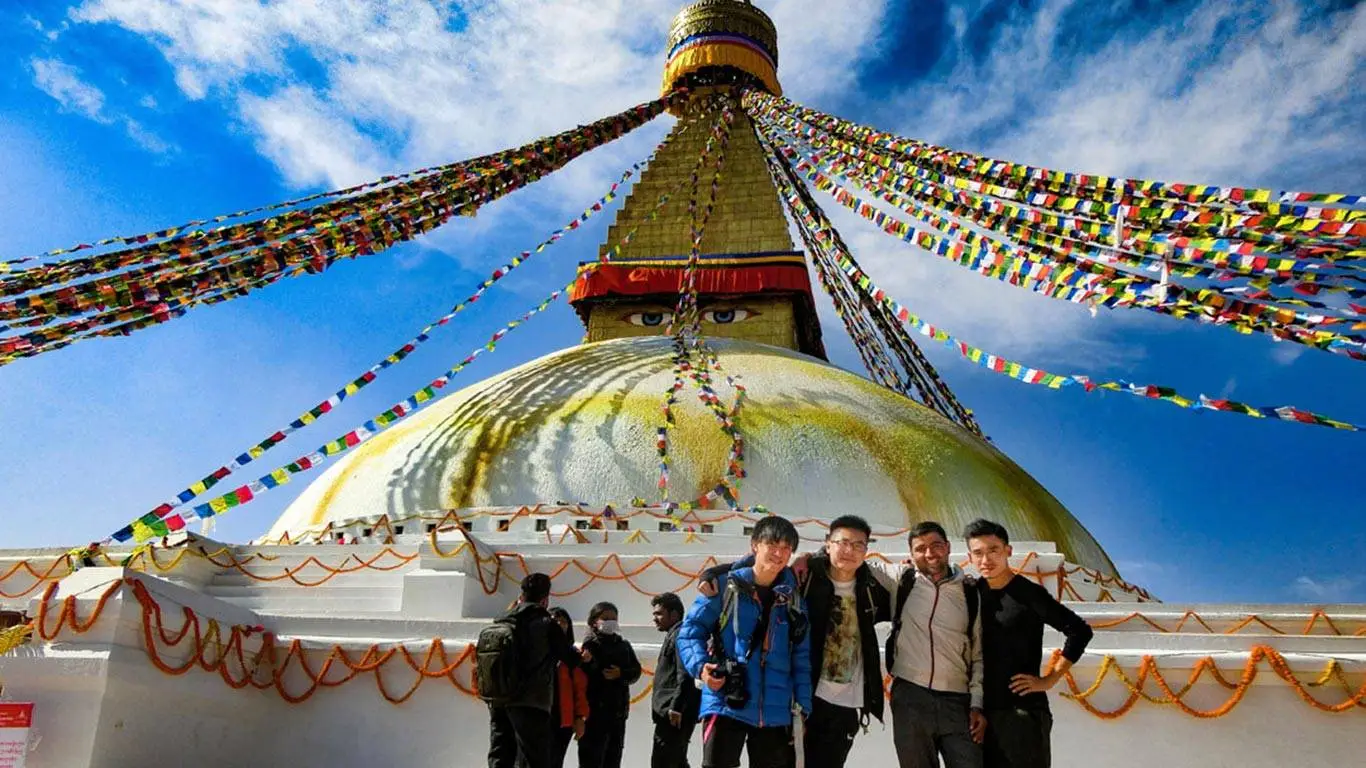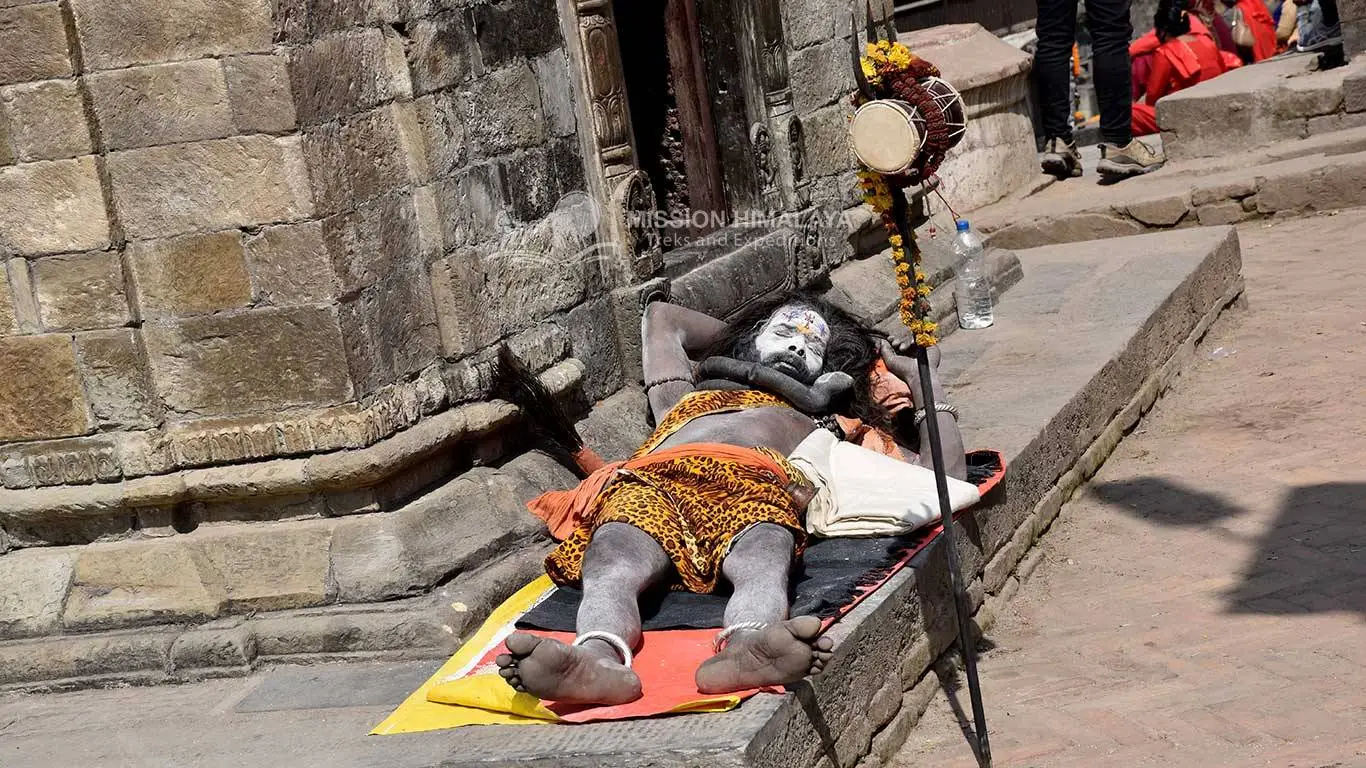The trekking equipment for Nepal trekking can be different according to the season and according to the trekking route you choose. because the temperature is different according to part of Nepal. Normal trekking equipment is as follows.
Clothing:
Boots and spare laces
Light shoes/trainers
Down jacket
Fleece or sweater
Shirts*3
Socks*3
Trekking trousers (or a long skirt for a woman)
Waterproof jacket /poncho/ umbrella
Overtrousers
Underwear (including thermals)
Gloves
Woolen Hat/ balaclava
Sunhat
Other Essential items
First Aid Kitbag
Trekking Poles
Sleeping bag(4 seasons +)
Sleeping bag liner
A water bottle (min 1-liter capacity) is a thermal better choice
Head Torch
Batteries for camera and torch.
Sunglasses
Sun cream (SPF 50) and lip salve
Towel and washing kit
Money belt
Map
Whistle
Toilet paper and lighter
Passport
Small padlock (to secure kitbag and lodge bedroom)
Optional things:
Notebook and pens
Altimeter
Binoculars
Gaiters
Plastic bags
Insulation Mat
Camera and plenty of drives
Personal snacks and other game equipment
Detailed Nepal Trek Equipment List
If you plan to go to Nepal For Trekking. Awesome!
This list recommends detailed information about every piece of equipment you need on your way to the most famous mountaineering base camp in the world.
This list can be used for all trekking in Nepal, including other famous trekking such as Annapurna Loop, Langtang Valley trekking, and Kanchenjunga base camp trek.
On the equipment list. We only recommend the equipment that we believe is the most cost-effective and best performance. We often receive feedback from readers and experienced Nepalese hikers who provide excellent insights into obscure but useful equipment.
Buy and rent
If you want to travel light, you will be happy to know that some of the following items can be rented or bought in Kathmandu or Nanchi Market. But please note that some cheaper local equipment often cannot be lower than in cold weather.
Clothing
A key concept to understand when hiking to Everest Base Camp is stratification.
The working principle of stratification is to allow moisture to pass from one layer to another is called moisture absorption. Therefore, each layer you use should be made of pluggable fabric and support the plugging process. For example, cotton is a hydrophilic material, which means it can absorb water and should therefore be avoided.
When you ascend or descend to altitude, the weather changes dramatically, so the ability to layer up or down is very important.
This is especially evident in the process of climbing Everest Base Camp. At Everest Base Camp, you will trek 2,800 meters from Lucca to 5,554 meters from Carla Paternal. You will notice that day and night temperatures vary greatly from low altitude (<3,500 meters) to high altitude (>3,500 meters).
Seasonal changes are also a key consideration in your clothing layering system.
The peak seasons from March to May and September to November usually provide good weather, but rain may be encountered downstream of the hike (below 3,500 meters), and snow may be snowed at any altitude in the Khumbu area. In the first few days of the long journey, the temperature during the day can be moderate to warm, but when you reach Nanchi, you will feel a biting chill in the air, and it will become very cold in the morning and at night!
We strongly recommend that you avoid the monsoon season (June-August). If you are used to multi-day cold travel, we only recommend that you hike in the cold winter (December-February).
So, now that you have understood the concept of layering, here are the layers of clothing you need to carry with you.
Breathable panties
You have to trek for 4-7 hours a day. You want to make sure you have comfortable and breathable underwear. To facilitate sweat absorption, we recommend bringing 4-6x pairs of breathable sports underwear (icebreaker or high-absorbent underwear produced by Adidas), and a double sports bra for women.
Again, you don’t want cotton because you will reuse your underwear. Trust me, after 3 days of hiking, things in your pants start to smell bad.
Baselayer
The best base layer is next to the skin (to reduce airflow) and is composed of highly hygroscopic materials that allow moisture to escape.
The bottom garments we recommend are produced by Smartwool or Icebreaker brands that offer market-leading lightweight Merino wool products at moderate prices.
We recommend getting 2x top layer and 1x bottom layer.
Hiking shirt
Regarding your general trekking clothes, we recommend bringing 4-6 trekking shirts (short and long sleeves), which you will wear on most trekking days. These lightweight, breathable shirts are good, or any Icebreaker or Columbia shirts are good.
Note: Make sure that the shirt is made of high-fiber materials, such as merino wool because you will reuse it for several days. Cotton is not a very good material because it absorbs water and therefore becomes very smelly, very fast.
Hiking pants and shorts
We also recommend bringing 2 pairs of trekking trousers. Recommended brands include Craghoppers, O’Neills, or Columbia.
Wool jacket
The second layer, or insulation layer, is located on your base layer, preferably made of wool or micro-wool material.
For your body, we recommend a Polartec 200 wool jacket. These jackets are great for hiking because they are lightweight, provide good warmth, and release moisture (or breathability).
softshell
The third layer, the outer core layer, consists of a warm and waterproof jacket and trousers. You can use it in the upper reaches of the Everest Base Camp hiking.
As far as the jacket is concerned, we think this is a lifetime investment because this jacket should last you for many years. Other excellent winter jackets suitable for EBC include Arc’teryx Atom, RAB microlight, and Mountain Hardware.
Synthetic alternatives are good, but just make sure they have a good heat-to-weight ratio.
For your pants, you should look for warm, wool-insulated hiking pants or ski pants. Recommended brands include “Invasion”, “Hayley Hansen” or “O’Neills”.
Jacket shell
You can encounter rain downstream from the hike, especially if you plan to hike on either side of the rainy season (June-September). You should bring a waterproof hard shell jacket, solution, and a pair of waterproof outer pants, preferably made of gore-tex material.
Sun protection hat
A hiking hat that can protect the face and neck from the sun is a must. Make sure your hat is light and easy to handle to fit your daily packaging.
Fleece hat or turban
The weather starts to get very cold in the late afternoon/early evening; especially when you are near Everest Base Camp. A warm woolen sweater or turban is a must.
The North Face and Berghaus provided good beans.
Magic scarf
The temperature can get very cold and the air is usually very dry, which can cause the infamous kelp cough.
Face towels prevent particles from entering your throat when you breathe.
In the off-season winter months (December, January, and February), we strongly recommend bringing a towel.
Gloves
Just like clothes and underwear, you need to bring them on a normal hike to keep your sunscreen and warmth. We recommend lightweight, fast-drying gloves made of wool material.
Outer gloves
Your outer gloves need to be super warm, waterproof, and very durable.
We recommend Gore-Tex gloves from Dakine, Black Diamond, and North Face.
Shoes
Shoes are very important because your feet are the most important. Having comfortable shoes will make your hike more enjoyable because no one wants to be bothered by blisters or foot pain.
Before climbing Everest Base Camp on foot, make sure you wear boots. This means at least 2-3 long hikes (5-6 hours) in new boots before arriving in Nepal.
Below we will focus on 5 pieces of footwear and equipment that you should carry with you when hiking at the Everest Base Camp.
Hiking shoes
Your hiking boots may be the most important item you can carry on your hike to Everest Base Camp- your feet are the key to your arrival and return to the base camp. Boots of the wrong size can cause painful blisters, peeling nails, and sore feet.
Make sure your boots fit. You can put your feet in the boots without tying your shoes and slide them forward until your toes are comfortably attached to the front of the boots. You should be able to put a finger between the heels of the shoe. If you have a lot of space for your fingers, then the boots are too big, if you have difficulty getting your fingers comfortable, the boots are too small another size!
Reliable but affordable brands include Salomon, Scarpa, Karrimor, Berghaus, and Hi-Tec. To get the best results in professional boots, you can look at the Scarpa Kenash or Meindl trekking boots series or Solomon (see quest series) or anything.
Sports shoes (Hiking shoes)
We suggest that you wear a pair of basic light sports shoes in the inn after a long day of trekking.
Here are some hiking shoes or hiking sandals, we recommend.
Wearing sandals and warm socks at the inn is a good choice.
Hiking socks
You should bring 4-6 pairs of hiking socks. We recommend Coolmax hiking socks, or Smartwool and Bridgedale socks.
Merino wool socks are great because they allow the feet to breathe, so they can be reused many times before they need to be washed.
Do not wear cotton socks, as they will absorb water and will only cause nasty blisters.
Warm socks
We recommend wearing a pair of warm socks when hiking in the cold near the camp.
We recommend Smartwool thermal socks because they provide good cushioning for the feet, are very warm, and have flat seams (heavy seams can cause blisters).
Other valuable brands include Bridgedale and Wigwam.
Snow cover
The leggings are made of waterproof material and extend from the boot to the calf.
They are used to prevent water, mud, dust, and small stones from entering your boots. There are many different types of snow cover on the market, but they all seem to do the same thing, so we don’t recommend them.
Packing equipment for Everest trekking
Duffel bag (camel bag)
If you participate in our club activities, we will arrange a porter, and we will provide you with a 120-150L duffel bag.
The bag is made of waterproof laminate material, with sturdy zippers and easy-to-access hand and shoulder straps.
Backpack
If you are hiking alone or without a porter, then you will want a 45-65L backpack. The open-top hiking backpack style is the best.
The Gregorian backpack is recommended here.
If a porter or yak is carrying your luggage or backpack, then you will want a lightweight backpack to carry necessities such as snacks, sunscreen, a camera, personal items (such as passports, and money), and hats.
The ideal backpack has compression straps to reduce the weight pressure on the back and side pockets and facilitate the retrieval of your water bottle.
Kitty is our preferred backpack. 22 liters is perfect.
Make sure your backpack has a rain cover. If you decide to use Kitty Hawk, then make sure you have an Osprey backpack raincoat that is the correct size.
Remarks: The waterproof effect of the rain cover is not particularly good. It is recommended that valuables be packed in a waterproof bag
Sleeping bag
A warm sleeping bag is absolutely a must because EBC can get very cold at night. We recommend duck-down/goose-down sleeping bags, but if you want to save money, synthetic cotton sleeping bags will do. Just make sure it applies to the four seasons and has a rating temperature scale of at least minus 10 degrees.
We recommend groundhog (bracket), north face (snow leopard), or mountain hardener (thin plate or phantom).
Finally, if you are not going to live in an inn, but go to business or camping in the wild, then a light sleeping pad is worth it.
Trekking poles
A good trekking pole can reduce the impact on knees and other leg joints by 20%. This is especially beneficial when the load on your joints increases exponentially.
We recommend buying adjustable light trekking poles (about 350 grams per pair), which are easy to store, durable, and versatile.
The black diamond trekking poles are great (our favorite is the black diamond Alps). Amazon recommended the option.
Sunglasses
Due to height and snow glare, the UV intensity in the Himalayas is relatively high.
Please make sure you bring a good pair of 100% UV protection sunglasses (at least 80% light reduction).
We recommend Julbo’s mountain sunglasses. Their Monte Bianco Mountains are very cool!
Headlamp
You will not hike at night, but you may need a headlight to hike to Karapatel in the early morning or evening.
In addition, many hotels have poor lighting. Your headlight can be used to go to the toilet at night, or if you want to read after dark.
Petzl Tikka is a leading headlight brand. Be sure to bring spare batteries.
Water bottle or water bag
Dehydration is a common problem in high-altitude areas. You should plan to drink 2-3 liters of water a day.
You can put water in a standard water bottle-we recommend buying 2 Camelbak water bottles-or if you have room for a water bag in your backpack (small eagle claws are fine), then a 2L platypus water bag is a good one The product.
Personal products and medicines
Hiking Towels- Small to medium-sized hiking towels are useful to wash and dry quickly afterward. “Discovery” or “life jackets” provide good, quick-drying hiking towels.
The small lock used to secure your duffel bag or backpack
Waterproof zipper bag-safe storage of important/valuable items such as your passport, money, and electrical equipment
Camera/Camcorder doesn’t explain how dramatic the views of Nepal and the Himalayas are. You will want to shoot your high-definition hiking story, so if you don’t have a decent camera right now, it’s time to invest. Here are some recommended DSLR cameras. Remember, you want to make sure that your camera is light but still able to capture high-quality images. As far as the camera is concerned, we are GoPro fans.
E-book/Kindle- During the long journey of EBC, there is a lot of time to rest. You need to read the material. The book is heavy and unwieldy, we recommend bringing a Kindle reader.
Playing cards to entertain you and other hikers at night
Notebook/diary and pen-record your hiking experience
Portable battery charger- If you plan to use electronic devices such as mobile phones, e-readers, or cameras/GoPro, then you need to make sure you can charge these devices. Most inns have sockets, but you have to pay and they are sometimes unreliable. We recommend bringing a USB portable battery charger. This usually applies to 5-6 recharges before they need to be recharged by themselves.
Water purification pills-you will need to treat your water in Nepal. Please do not buy bottled water, as this will only increase the waste problem in Nepal’s trekking industry. Be sure to add the correct number of water treatment tablets based on the volume of water in your bottle. During the long journey, 100 tablets are enough. You can also use a UV water purifier. We recommend SteriPEN Adventure Optimized Mini Package UV Water Purifier.
Instant granules-this are a good addition to your drink and help replace electrolytes, and improve energy levels, and water absorption.
An antidepressant is a high-altitude medicine that can be used as preventive medicine for acute altitude sickness (AMS) or altitude sickness. It cannot cure AMS, nor should it be used as a drop substitute (this is the only real solution for AMS). However, it can help prevent the occurrence of AMS and is often used by high-altitude travelers.
Please seek appropriate medical advice before taking ascorbic acid. You can read a detailed article about altitude sickness here. General medicine recommends taking paracetamol to treat headaches (a common symptom of altitude sickness) and diarrhea (another common problem because the food preparation area may be a bit unhygienic).
Basic first aid kit-our team will change the first aid kit for everyone, but there is nothing wrong with preparing more. If you are hiking alone, then a first aid kit is a must.
Sunscreen/lipstick-1x sunscreen (SPF 30) and 1x lipstick
Baby wipes-1 time baby wipes, convenient and quick to wash wet
Toiletries basic toiletries, including toothbrushes and toothpaste (remember to use pure water, because bacteria can easily enter the gums), 2 rolls of toilet paper (this can be bought on the road, but the quality is usually poor), etc.
The oximeter- Our team will provide it, it can show how altitude affects your body and how you adapt.
Note: do not bring too many things because the porter can carry a maximum of 25 kilos and airlines are not allowed to bring more than 20 kilos or 15 kilos only for Lukla flights.
Birendra Duwadi by profession a trekking and tourist guide and an enterpreur whose passion is trekking in the himalayas. Started Mission Himalaya Treks in 2015 with a new vision to introduce Nepal's Himlayas to the world. His vision is to explore and documentation new trekking routes . Birendra leads Mission Himalaya, a company that change the qualities of trekking in Nepal.












